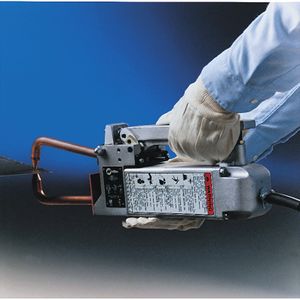Spot Welder
Make: Miller
Model: LMSW-52
Serial Number: MJ328801N
Ace: Needed (Makerhub@georgefox.edu).
Location: Welding Shop
Safety First
- Wear gloves and welding helmet.
- Don't have bare skin exposed.
- Don't weld in wet gear or standing water.
- Welded material will be hot.
Description
Resistance spot welding is a process in which contacting metal surface points are joined by the heat obtained from resistance to electric current. The Miller LMSW-52 Air-Cooled Spot Welder is a lightweight unit that is portable, easy to operate and excellent for welding mild, galvanized or stainless sheet materials.
- LMSW-52 spot welder manual [1]
Here is an example of spot welding and some good basic information.
Documentation
Terminology
- Electrode Tips – The copper ends of the tongs that make contact with the workpiece to deliver welding current.
- Arms / Handles – The insulated portions you hold; provide leverage to open/close the tongs.
- Jaws – The part of the tongs where the electrode tips are mounted; may pivot to adjust pressure.
- Adjustment Knob / Screw – Used to set electrode pressure for consistent welds.
- Cable / Conductor – Heavy cable connecting the tongs to the welder to carry welding current.
- Spring Mechanism – Internal spring that helps return the tongs to the open position when released.
- Insulation / Grip – Protective covering to prevent electric shock and allow safe handling.
Training
Operation
Here are some general setup rules of thumb:
- The maximum weld capacity is 2 sheets of 16 gauge material.
Demonstration
For the demonstration you will need to perform a spot weld using two pieces of scrap material.
General Procedure
- Ensure the material being welded should be clear of any oil or dust
- Turn on the spot welder
- Place the material being welded between the clamps.
- Clamp down on the two pieces of material for approximately 2 seconds. The time required to weld may vary slightly depending on the material and thickness.
- Grab workpiece with a set of pliers, and open the clamp.
Certification
Complete the Welding Shop - Spot Welder Module at the link below to gain access to the Spot Welder. The Maker Hub Canvas course pertains to all facilities and equipment contained in the Maker Hub; simply complete the quizzes for the facilities/equipment you wish to use in the Maker Hub. Please email makerhub@georgefox.edu if you have any questions.
Troubleshooting
- No weld or weak weld:
- Check electrode tips for wear, dirt, or oxidation; clean or replace as needed.
- Verify proper electrode pressure; adjust using the adjustment knob/screw.
- Ensure cables are securely connected and not damaged.
- Sparks at handles / arcing:
- Inspect insulation on handles and tongs; replace if cracked or damaged.
- Confirm all connections are tight and corrosion-free.
- Tongs won’t open/close smoothly:
- Check spring mechanism for damage or debris; clean and lubricate lightly if needed.
- Ensure pivot points are not seized or misaligned.
- Overheating tongs:
- Reduce duty cycle; allow tongs to cool between welds.
- Check for proper current settings and electrode contact.
- Uneven welds:
- Inspect electrode tips for uneven wear; dress or replace as needed.
- Confirm correct alignment of jaws and consistent pressure.
Maintenance
General maintenance
The welding tips should be inspected and cleaned as needed.
Specific Maintenance Tasks
| Maintenance Procedure | Frequency | Done By |
|---|---|---|
| N/A | N/A | N/A |

